The Story & Intro: Why Gluten-Free Sausage Rolls Are Worth It
When Helen Tois first started experimenting with gluten-free cooking, she faced countless challenges. One of her biggest hurdles was recreating the flaky pastry crust synonymous with traditional sausage rolls. But after years of trial and error, she mastered the art of gluten-free sausage rolls. These savory treats are now a staple on RecipesofMe , offering comfort and flavor without compromise. Helen’s journey proves that gluten-free doesn’t mean joy-free—especially when it comes to hearty dishes like Gluten-Free Potato Buns.
Gluten-free sausage rolls are more than just a dish; they’re a celebration of creativity in the kitchen. Whether you’re catering to dietary restrictions or simply exploring new flavors, these rolls deliver. Imagine biting into a golden crust filled with spiced sausage—a dish so satisfying it rivals its gluten-laden counterpart. With the right ingredients and techniques, anyone can master gluten-free sausage rolls.
Table of Contents

Essential Ingredients for Flaky Gluten-Free Sausage Rolls
Choosing the Right Gluten-Free Flour Blend
Success in gluten-free pastry begins with selecting the right flour combination. Achieving bakery-quality gluten-free sausage rolls requires a thoughtfully balanced blend that delivers the same structure and flaky texture that wheat flour provides effortlessly. An effective homemade mixture combines rice flour to create lightness, tapioca starch to develop proper chew, and potato starch in smaller quantities for ultimate tenderness. The addition of xanthan gum (roughly 1/2 teaspoon per cup of flour blend) proves indispensable—this binding agent works tirelessly to maintain pastry integrity and prevent frustrating crumbling.
Pre-made gluten-free flour blends designed for pastry or shortcrust can also work well, but always check the label to ensure they contain xanthan gum or add it yourself. The fat content is equally important; cold butter, cut into small cubes, creates those desirable layers when baked.
Discovering your ideal blend may require some delicious trial and error along the way. Some bakers swear by blends containing a small amount of almond flour for added richness and moisture, though this can make the pastry more delicate. For a heartier flavor, incorporating a tiny bit of finely ground ancient grains like millet or sorghum can add depth, but keep the proportion low to avoid toughness.
Remember, the key is achieving a dough that’s smooth, pliable, and holds together without being sticky. If your dough feels too dry, add a teaspoon or two of ice-cold water. If it’s too sticky, dust it lightly with more flour blend. For more tips on working with gluten-free doughs, check out our guide on gluten-free pie crusts.
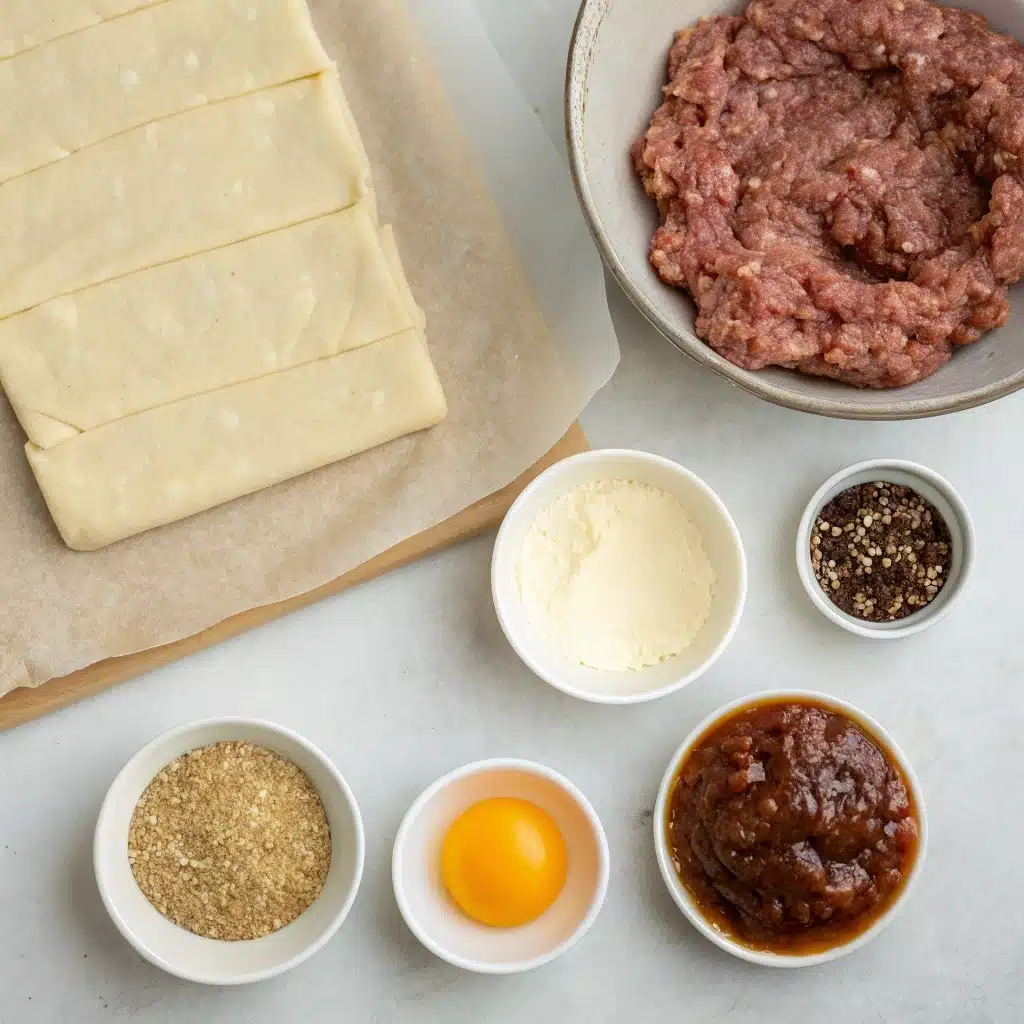
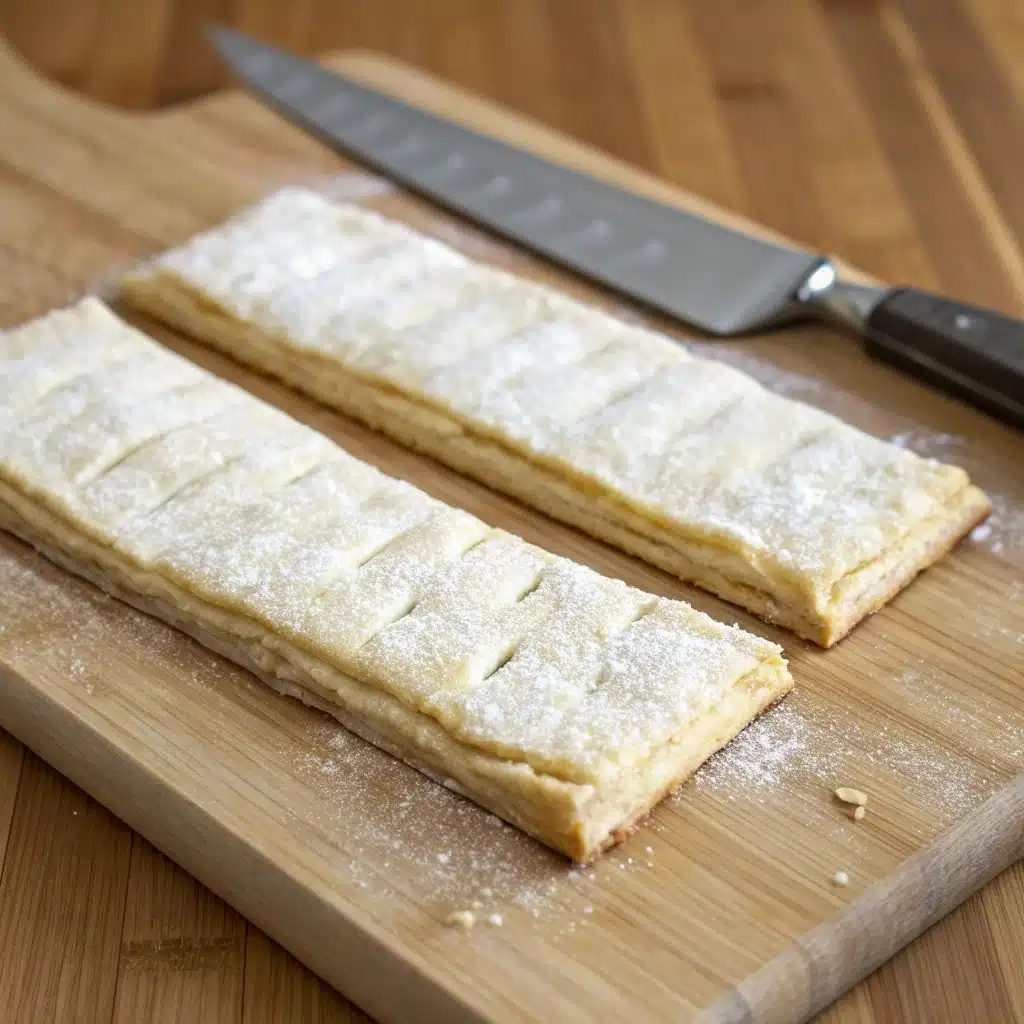

The Story & Intro: Why Gluten-Free Sausage Rolls Are Worth It
- Total Time: 40 minutes
- Yield: 16 pieces 1x
Description
Delicious gluten-free sausage rolls with flaky pastry and savory beef filling. Perfect for lunch, snacks, or appetizers.
Ingredients
280g chilled gluten free puff pastry sheet (JusRol or Asda both do excellent ones)
350–400g gluten free beef sausages or sausage meat
1 medium egg
(optional) 100g chutney (e.g., Stokes Chilli Jam)
(optional) 1 tbsp sesame seeds
Instructions
1. Pre-heat the oven to 200°C (180°C fan). Line a baking tray with parchment paper.
2. If using whole sausages, carefully snip a small hole in the end of each casing and squeeze the meat into a bowl. Discard the empty skins.
3. Use a wooden spoon to break up any large chunks of sausage meat until you have a smooth mixture. Season if needed and mix in chutney if using. Set aside.
4. Remove the gluten free puff pastry from its packaging, keeping it on the non-stick paper. Slice it in half lengthways to create two long rectangles.
5. Divide the sausage meat between the two pastry rectangles. Use a teaspoon to heap it along the center of each strip, then use your fingers to compact and fill any gaps.
6. Crack the egg into a small bowl and whisk lightly. Brush some egg wash along one of the long edges of each pastry rectangle.
7. Carefully fold the other edge of the pastry over the filling, rolling it towards the edge with the egg wash to seal. Press gently to secure.
8. Transfer the long rolls to the baking tray. Brush the entire surface of each roll with the remaining egg wash.
9. Sprinkle with sesame seeds if desired. Using a sharp knife, cut each roll into 8 even pieces, cutting straight down.
10. Place the tray in the oven and bake for approximately 20 minutes, until the pastry is puffed and golden brown.
Notes
For best results, keep the pastry and filling as cold as possible while working.
If the pastry becomes too soft, chill the assembled rolls for 10 minutes before baking.
Leftover rolls can be stored in the fridge for up to 3 days and reheated in the oven for the best texture.
These rolls freeze well; wrap individually and store for up to 2 months. Thaw and reheat before serving.
- Prep Time: 20 minutes
- Cook Time: 20 minutes
- Category: Appetizer
- Method: Baking
- Cuisine: British
Nutrition
- Serving Size: 1 roll
- Calories: 250
- Sugar: 3g
- Sodium: 450mg
- Fat: 18g
- Saturated Fat: 8g
- Unsaturated Fat: 8g
- Trans Fat: 0g
- Carbohydrates: 12g
- Fiber: 1g
- Protein: 10g
- Cholesterol: 60mg
Selecting and Preparing the Sausage Filling
The heart of a great sausage roll is, of course, the sausage filling. For this recipe, we use gluten-free beef sausage, which provides a robust and satisfying flavor. When buying pre-made sausages, always verify the label to ensure they are certified gluten-free, as some brands use fillers or flavorings containing gluten. Alternatively, you can buy gluten-free sausage meat or make your own by grinding beef with gluten-free seasonings like salt, pepper, sage, thyme, and a pinch of nutmeg. The meat should be well-seasoned but not overly wet; excess moisture can make the pastry soggy.
Preparing the filling is straightforward. If using whole sausages, carefully snip the casings and squeeze the meat out into a bowl, discarding the skins. Use a wooden spoon to break up any large chunks, creating a smooth, even mixture. At this stage, you can add optional flavorings like a spoonful of your favorite chutney or a finely chopped shallot for extra depth. Mix these additions in gently.
After preparing the filling, reserve it temporarily while you focus on creating a perfectly rolled pastry.. Ensuring your sausage filling is at room temperature or slightly chilled (not warm from handling) helps prevent the pastry from becoming greasy during baking. For more ideas on gluten-free meat preparations, see our post on flavorful gluten-free meatballs.
Step-by-Step Instructions for Perfect Gluten-Free Sausage Rolls
Preparing the Pastry and Filling
Set it on a cutting board and divide it in half lengthwise using a sharp, clean knife. While the pastry chills, prepare your filling. If using whole gluten-free sausages, carefully snip a small hole in the end of each casing and squeeze the meat into a bowl, discarding the skins. Use a wooden spoon to break up any large chunks of gluten-free beef sausage until you have a smooth mixture. Season the meat if needed, and if using, mix in your chosen chutney (like the Stokes Chilli Jam mentioned) or finely chopped shallots. Set this mixture aside.
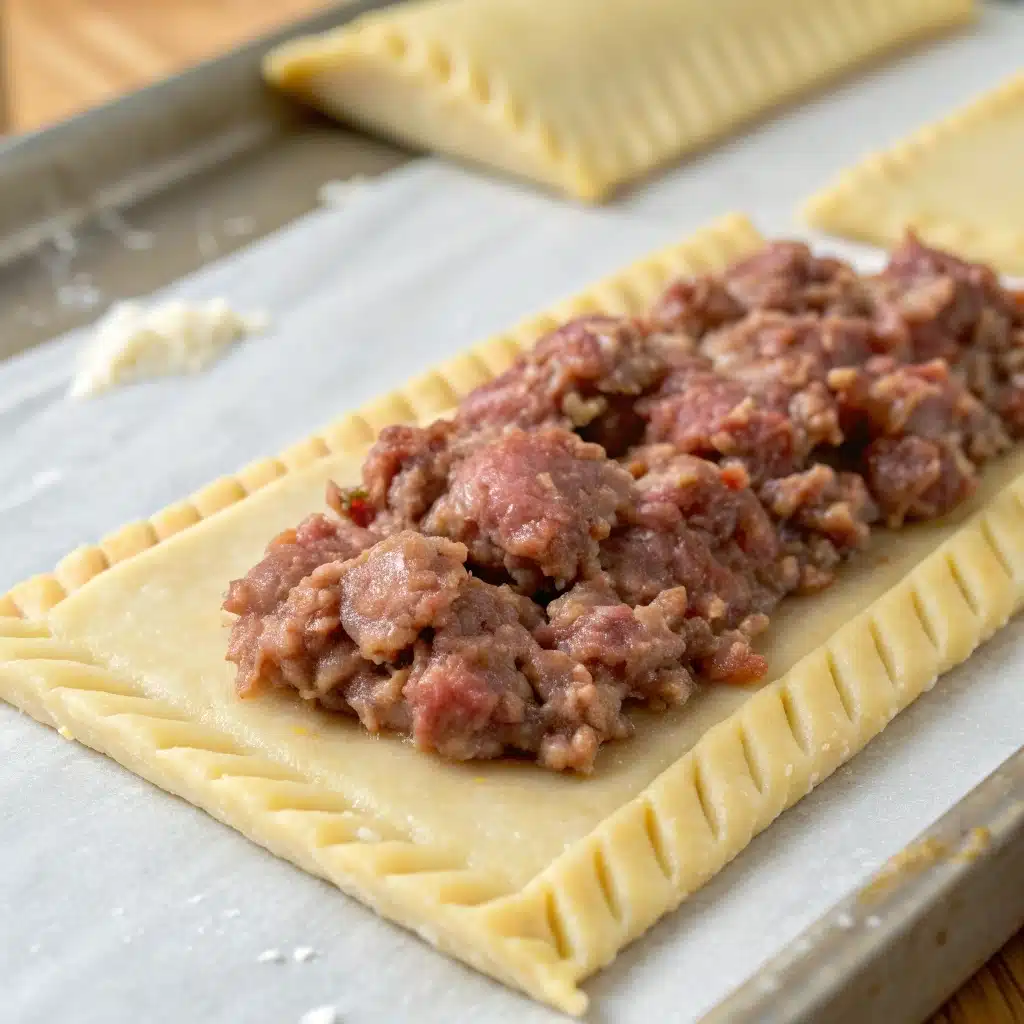
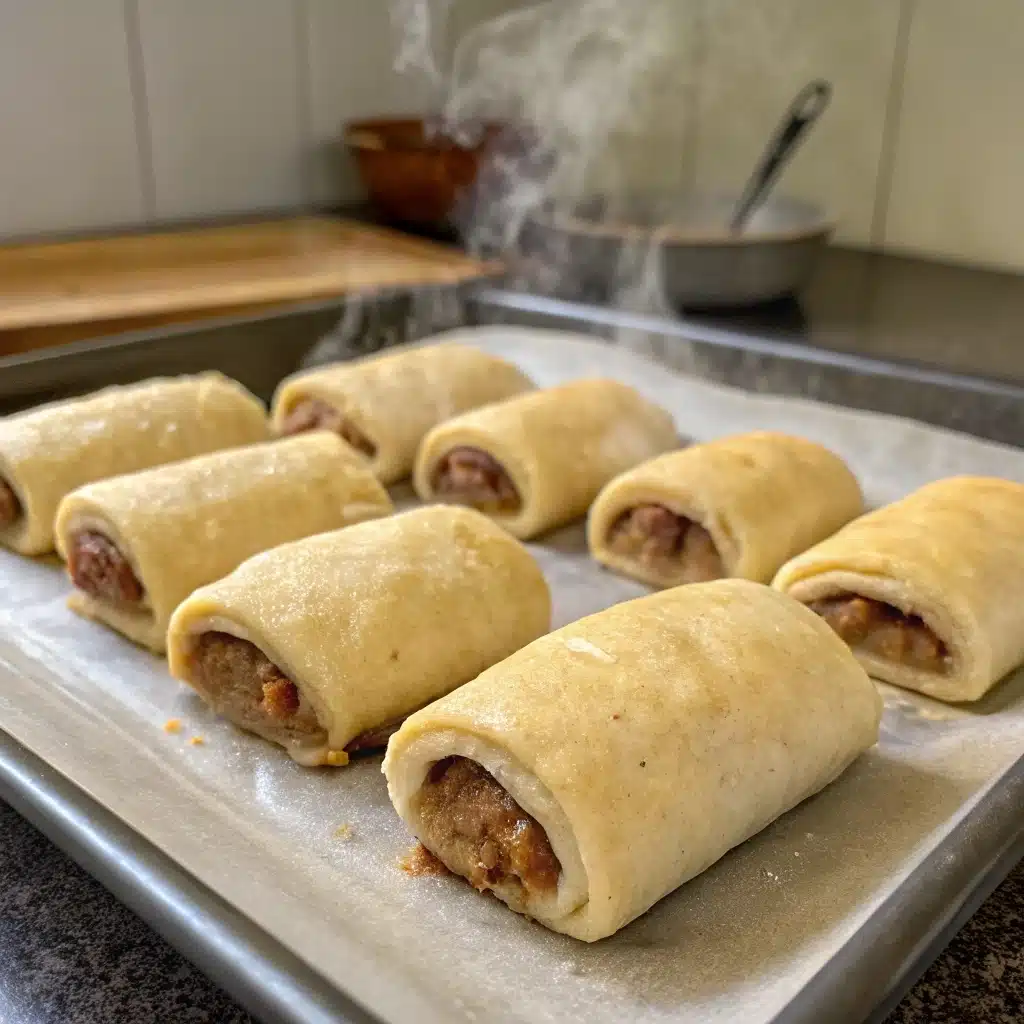
Assembling and Baking Your Sausage Rolls
Distribute the seasoned sausage meat evenly across both pastry rectangles for uniform rolls. Break an egg into a small bowl and whisk it gently until well blended. This will be your egg wash. Using a pastry brush, brush a thin layer of the beaten egg along one of the long edges of each pastry rectangle. This egg wash acts as glue, helping to seal the pastry closed.
Gently bring the untreated long edge of the pastry over the sausage filling, then roll it toward the egg-washed edge to seal. Press gently along the sealed edge to ensure it sticks. Once rolled, transfer the long sausage rolls to your prepared baking tray.
Brush the entire surface of each roll generously with the remaining egg wash. This will give them a beautiful, golden color. For extra flavor and an attractive finish, scatter sesame seeds across the top if you wish. With a sharp knife, slice each lengthy roll into 8 uniform pieces. Be sure to cut straight down to avoid sealing the ends, which helps them puff up nicely.
Place the tray in the preheated oven and bake for approximately 20 minutes, or until the pastry is puffed and a rich, golden brown. The filling must reach a fully cooked, steaming hot temperature throughout. Monitor them closely during the final minutes to avoid excessive browning. For more gluten-free baking inspiration, explore our collection of easy gluten-free appetizers.
Table: Key Steps at a Glance
| Step | Action | Tip |
|---|---|---|
| 1 | Slice Pastry | Keep chilled for easier handling. |
| 2 | Prepare Filling | Break up meat well for even texture. |
| 3 | Apply Egg Wash | Brush only one edge for sealing. |
| 4 | Roll & Seal | Press gently to secure the edge. |
| 5 | Egg Wash Again | This ensures a golden finish. |
| 6 | Slice & Bake | Use a sharp knife for clean cuts. |
Troubleshooting and Serving Tips for Gluten-Free Sausage Rolls
Common Issues and How to Fix Them
Despite following a perfect recipe, occasional challenges can still arise during baking. If your gluten-free sausage rolls turn out too crumbly, the dough might have been too dry. For your next batch, incorporate one to two teaspoons of ice water into the pastry dough. On the flip side, if the dough becomes sticky and difficult to manage, sprinkle it gently with your gluten-free flour blend. Remember, the dough should feel slightly tacky but not wet.
If your pastry isn’t as flaky as you’d like, the butter might not have been cold enough, or the oven temperature could be off. Ensure your butter is very cold and cut into small cubes before incorporating it. Also, double-check your oven temperature with an oven thermometer for accuracy. If the rolls are browning too quickly on top but not cooking through inside, try covering them loosely with foil for the last part of baking. For issues with the filling, like it being too dry or not holding together, make sure you’re using a good quality gluten-free beef sausage with a decent fat content, and avoid overcooking the meat mixture before assembling.
Another common issue is the rolls not rising properly. This often happens if the pastry gets too warm while you’re working with it. Keep everything as cool as possible – work quickly, and if necessary, pop the assembled (but unbaked) rolls back in the fridge for 10-15 minutes before baking. This helps the pastry firm up and achieve better lift. If the edges don’t seal well, ensure you’ve applied enough egg wash to the edges and pressed them together firmly.
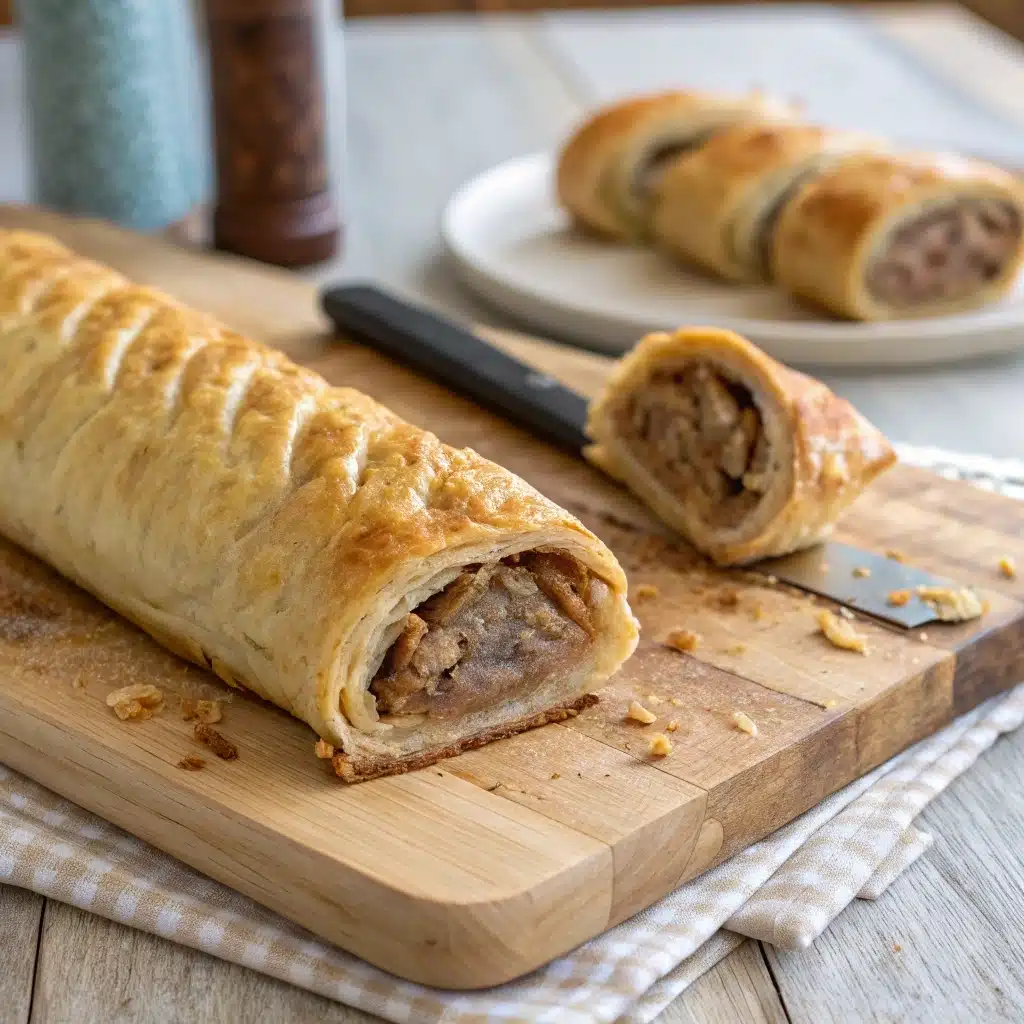
Serving Suggestions and Storage
Fresh from the oven, these gluten-free sausage rolls are absolutely delicious on their own. However, they’re also fantastic served with a variety of accompaniments. A dollop of tangy mustard, a spoonful of tangy chutney, or even a simple side of gluten-free ketchup can elevate them. For a more substantial meal, serve them alongside a crisp green salad or roasted vegetables. They also make excellent party appetizers or a hearty snack for on-the-go.
Storage is simple. Once cooled completely, store the sausage rolls in an airtight container in the refrigerator for up to 3 days. To reheat, place them on a baking sheet and warm them in a preheated 180°C oven for about 10 minutes, or until heated through. This helps restore the pastry’s crispness. You can also reheat them in the microwave for about 30 seconds, though the pastry might lose some of its flakiness.
For longer storage, these rolls freeze beautifully. Wrap them individually in plastic wrap, then place them in a freezer bag. They’ll keep for up to 2 months. Allow to thaw completely overnight in the refrigerator, then reheat to your desired temperature when ready to serve.
Frequently Asked Questions About Gluten-Free Sausage Rolls
Is Jimmy Dean regular sausage roll gluten-free?
No, Jimmy Dean’s regular sausage rolls are not gluten-free. They contain wheat-based ingredients in both the pastry and often in the sausage filling. Always check product labels carefully, as formulations can change.
Can you make gluten free sausage rolls?
Absolutely! Gluten-free sausage rolls are entirely possible with the right ingredients. Using certified gluten-free puff pastry and gluten-free sausage meat (or carefully de-cased regular sausages) yields excellent results. The key is using a good gluten-free flour blend with xanthan gum for the pastry.
What brand of pork sausage is gluten-free?
Many brands offer gluten-free sausages, but it’s crucial to read labels. Applegate, Aidells, and Wellshire Farms are known for their gluten-free options. However, since this recipe uses beef, look for certified gluten-free beef sausages or use gluten-free beef sausage meat.
Is Smithfield sausage gluten-free?
Smithfield’s product line varies. Some of their plain sausages may be gluten-free, but many contain fillers or seasonings with gluten. Always verify the specific product’s ingredients list before purchasing, especially for processed varieties.
Can celiacs eat gluten free sausages?
Yes, celiacs can safely eat sausages labeled as certified gluten-free. These products must contain less than 20 parts per million of gluten, making them safe for a gluten-free diet. When in doubt, choose certified gluten-free options to avoid cross-contamination risks.
What are the best gluten free sausages?
The best gluten-free sausages are those that are certified gluten-free and made with high-quality ingredients. Look for brands that specifically label their products as gluten-free. For beef sausages, Applegate’s grass-fed beef sausages and Coleman Natural Foods often have gluten-free options. Always read the label to confirm.
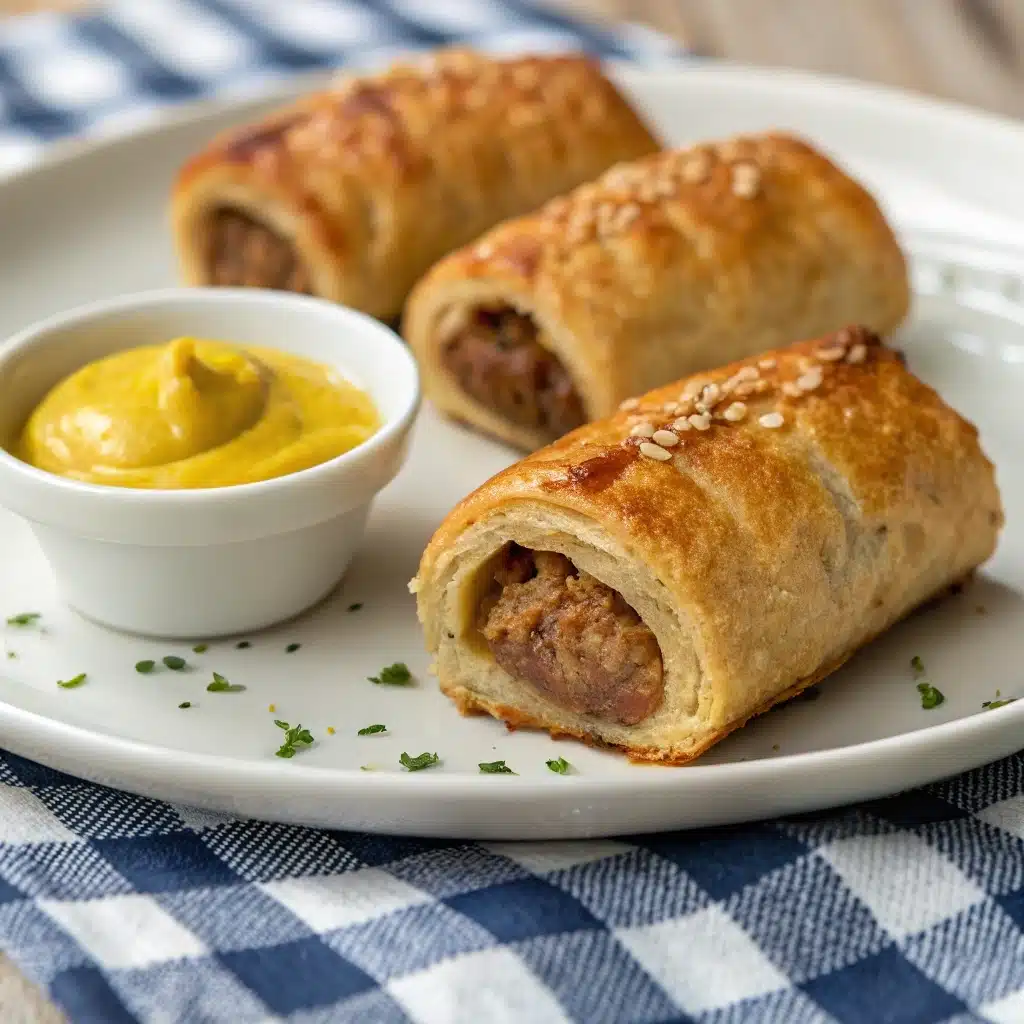
Conclusion
Making gluten-free sausage rolls might seem daunting at first, but with the right techniques and ingredients, they become a rewarding and delicious project. Helen Tois’s journey with gluten-free cooking has shown that dietary restrictions don’t have to limit flavor or satisfaction.
By choosing the right gluten-free flour blend, properly preparing your beef filling, and following the assembly steps carefully, you can create sausage rolls that are just as flaky and savory as their traditional counterparts. Remember to keep your ingredients cold, work efficiently, and don’t skip the egg wash for that perfect golden finish. Whether you’re making them for a quick lunch, a party appetizer, or a hearty snack, these gluten-free sausage rolls are sure to impress. So roll up your sleeves, preheat that oven, and enjoy the process of creating something truly special.
For more Gluten-Free recipes, follow me on Facebook and Pinterest.